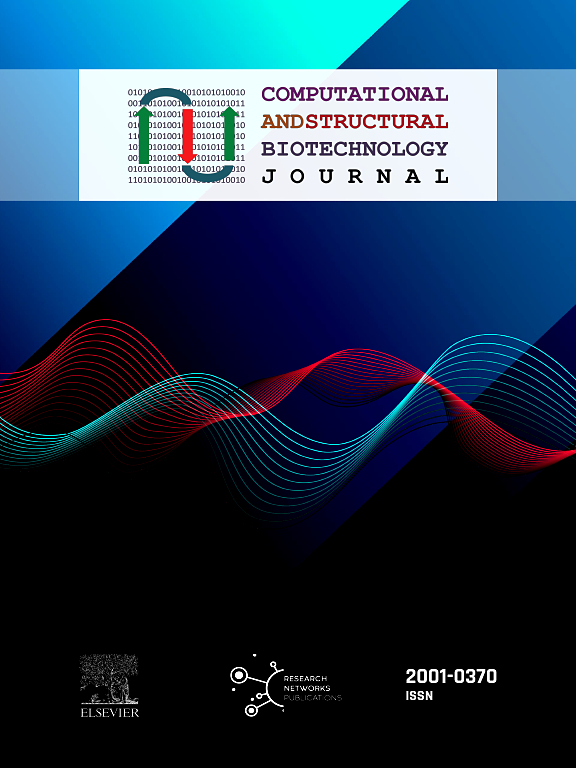CTGCT, Centre of Excellence for the Technologies of Gene and Cell Therapy: Collaborative translation of scientific discoveries into advanced treatments for neurological rare genetic diseases and cancer
IF 4.4
2区 生物学
Q2 BIOCHEMISTRY & MOLECULAR BIOLOGY
Computational and structural biotechnology journal
Pub Date : 2025-01-01
DOI:10.1016/j.csbj.2024.11.051
引用次数: 0
Abstract
The emerging field of precision medicine relies on scientific breakthroughs to understand disease mechanisms and develop cutting-edge technologies to overcome underlying genetic and functional aberrations. The establishment of the Centre of Excellence for the Technologies of Gene and Cell Therapy (CTGCT) at the National Institute of Chemistry (NIC) in Ljubljana represents a significant step forward, as it is the first centre of its kind in Slovenia. The CTGCT is poised to spearhead advances in cancer immunotherapy and personalised therapies for neurological and other rare genetic diseases. The centre’s overarching mission is to extend beyond the NIC’s scientific excellence in basic research and bring new therapeutic solutions toward clinical application. The CTGCT aims to develop a broad pipeline of biomedical tools, including innovative synthetic biology tools, gene editing and splicing technologies, RNA-based technologies, immune regulation engineering and novel viral and non-viral delivery systems. The CTGCT is supported by partner institutions from the UK, the Netherlands and Germany, which already have academic good manufacturing practice (GMP) facilities for the manufacture of advanced therapy medicinal products (ATMPs) and is committed to active collaboration with clinicians and patient organizations at all stages of development to improve access to gene and cell therapies (GCTs) for patients. The Centre also seeks to collaborate with national and international academic and industrial partners, and the newly established GMP facilities will address a critical bottleneck in the translation of GCTs from research to practice. Finally, CTGCT's translational research and technology transfer units will ensure the impactful dissemination of research and innovation activities in Slovenia, throughout the Western Balkans and Eastern Europe region, and beyond. With its comprehensive approach and forward-looking vision, the CTGCT will drive transformative advances in gene and cell therapies for the benefit of patients on a global scale.
基因和细胞治疗技术卓越中心:合作将科学发现转化为神经系统罕见遗传疾病和癌症的先进治疗方法。
新兴的精准医学领域依赖于科学突破来理解疾病机制,并开发尖端技术来克服潜在的遗传和功能失常。在卢布尔雅那的国家化学研究所建立基因和细胞治疗技术卓越中心(CTGCT)是向前迈出的重要一步,因为它是斯洛文尼亚第一个此类中心。CTGCT将引领癌症免疫治疗以及神经和其他罕见遗传疾病的个性化治疗。该中心的首要任务是超越NIC在基础研究方面的卓越科学成就,并为临床应用带来新的治疗解决方案。CTGCT旨在开发广泛的生物医学工具,包括创新的合成生物学工具、基因编辑和剪接技术、基于rna的技术、免疫调节工程以及新型病毒和非病毒传递系统。CTGCT由来自英国、荷兰和德国的合作机构提供支持,这些机构已经拥有制造先进治疗药物(atmp)的学术良好生产规范(GMP)设施,并致力于在开发的各个阶段与临床医生和患者组织积极合作,以改善患者获得基因和细胞疗法(gct)的机会。该中心还寻求与国内和国际学术和工业伙伴合作,新建立的GMP设施将解决gct从研究到实践转化的关键瓶颈。最后,CTGCT的转化研究和技术转让单位将确保在斯洛文尼亚、整个西巴尔干和东欧地区以及其他地区有效地传播研究和创新活动。凭借其全面的方法和前瞻性的愿景,CTGCT将推动基因和细胞治疗的变革性进步,造福全球患者。
本文章由计算机程序翻译,如有差异,请以英文原文为准。
求助全文
约1分钟内获得全文
求助全文
来源期刊

Computational and structural biotechnology journal
Biochemistry, Genetics and Molecular Biology-Biophysics
CiteScore
9.30
自引率
3.30%
发文量
540
审稿时长
6 weeks
期刊介绍:
Computational and Structural Biotechnology Journal (CSBJ) is an online gold open access journal publishing research articles and reviews after full peer review. All articles are published, without barriers to access, immediately upon acceptance. The journal places a strong emphasis on functional and mechanistic understanding of how molecular components in a biological process work together through the application of computational methods. Structural data may provide such insights, but they are not a pre-requisite for publication in the journal. Specific areas of interest include, but are not limited to:
Structure and function of proteins, nucleic acids and other macromolecules
Structure and function of multi-component complexes
Protein folding, processing and degradation
Enzymology
Computational and structural studies of plant systems
Microbial Informatics
Genomics
Proteomics
Metabolomics
Algorithms and Hypothesis in Bioinformatics
Mathematical and Theoretical Biology
Computational Chemistry and Drug Discovery
Microscopy and Molecular Imaging
Nanotechnology
Systems and Synthetic Biology
 求助内容:
求助内容: 应助结果提醒方式:
应助结果提醒方式:


